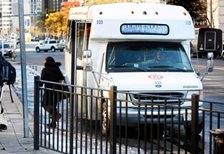Project Background
 The North Jersey Transportation Planning Authority (NJTPA), together with Hudson County, commissioned the Hudson County Jitney Study to specifically evaluate the role of jitneys and provide recommendations for improved integration into the broader transportation network. The objectives of the Hudson County Jitney Study were to better understand current jitney services and provide recommendations to benefit jitney customers, operators, and Hudson County as a whole. This was accomplished through an inventory of jitney and non-jitney operations in Hudson and the surrounding counties, and an evaluation their impacts on the overall transportation network. The study also examined the regulatory framework governing jitneys and developed recommendations to address operations, safety, and other jitney-related issues.
The North Jersey Transportation Planning Authority (NJTPA), together with Hudson County, commissioned the Hudson County Jitney Study to specifically evaluate the role of jitneys and provide recommendations for improved integration into the broader transportation network. The objectives of the Hudson County Jitney Study were to better understand current jitney services and provide recommendations to benefit jitney customers, operators, and Hudson County as a whole. This was accomplished through an inventory of jitney and non-jitney operations in Hudson and the surrounding counties, and an evaluation their impacts on the overall transportation network. The study also examined the regulatory framework governing jitneys and developed recommendations to address operations, safety, and other jitney-related issues.
This report synthesized the work completed throughout the study (2010-2011) and incorporates valuable feedback from the Technical Advisory Committee (TAC) that was formed to guide the project. The TAC included a variety of stakeholders from Hudson County and local municipalities, jitney operators, NJ TRANSIT, the Port Authority of New York and New Jersey, Hudson TMA, the Hudson County Prosecutor’s Office, the New Jersey Motor Vehicle Commission, and other stakeholders, including the Passaic County Planning Department. Jitney services were identified through primary data collection and field work conducted by the study team in 2010 and 2011 and supplemented by invaluable input from the Technical Advisory Committee.
Study Goals
The Hudson County Jitney Study, completed in 2011, built off of the 2007 Hudson County Bus Study by studying jitney operations in more detail. Tasks completed in this study included:
-
Development of an inventory of all jitney operations in Hudson County;
-
Identification the ownership and financial structure of jitney operators;
-
A literature search and provide examples or "best practices" of how jitney services operate in other areas of the country;
-
Identification and detail the impacts of jitney service on the County's transportation system;
-
Researched the legal and regulatory environment governing regulation of jitney operations;
-
Conducted an outreach effort to jitney operators and riders in order to understand their needs and preferences, and opportunities for improvement; and
-
Developed recommendations for increasing the regulation of jitney operations, improving their service, enforcement and regulatory compliance of jitney operations, enhancing jitney services, and better integration of jitney services into the overall transportation system.
Contact Jeffrey Perlman at [email protected].